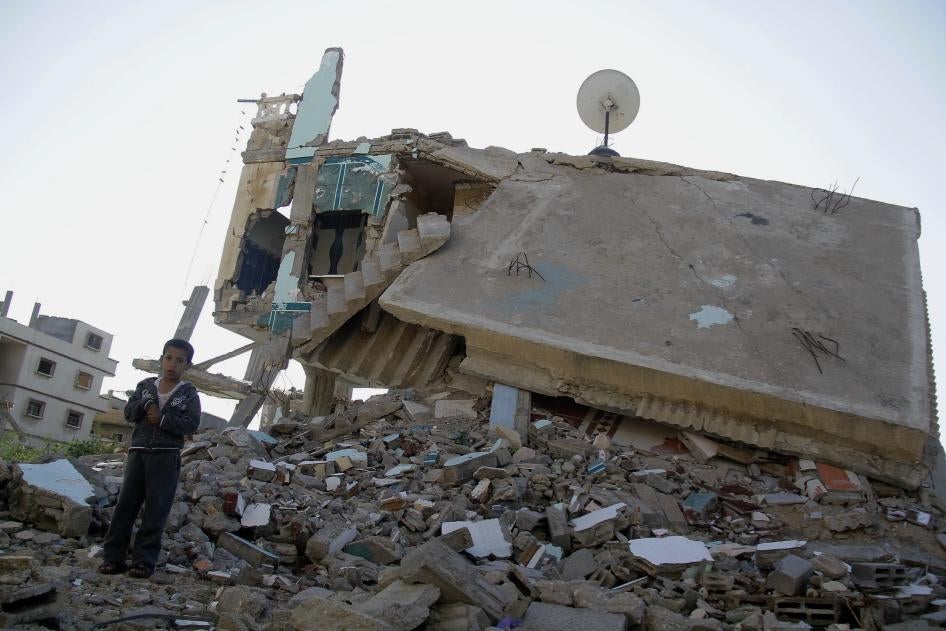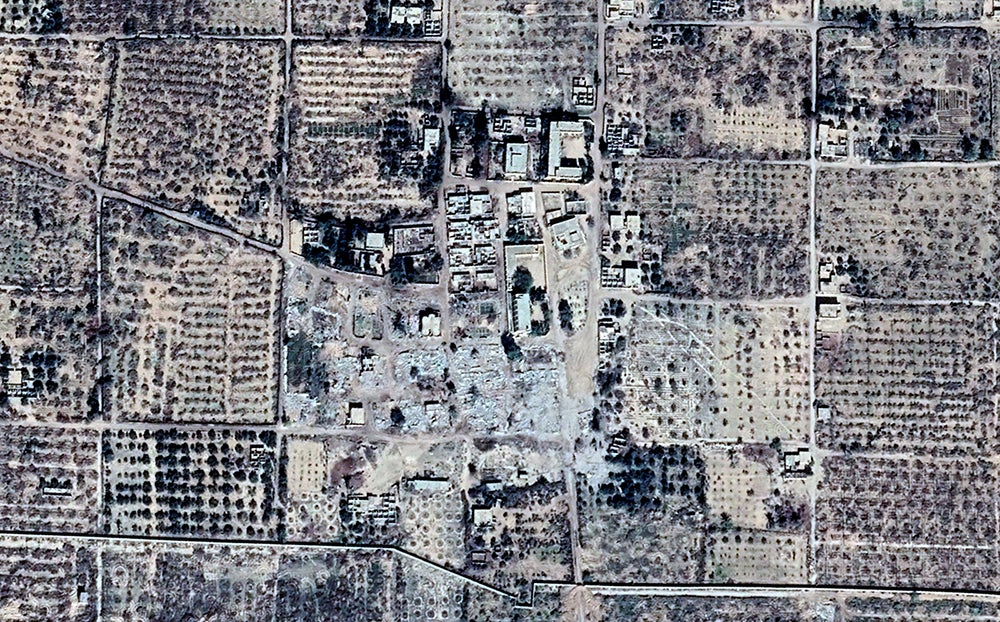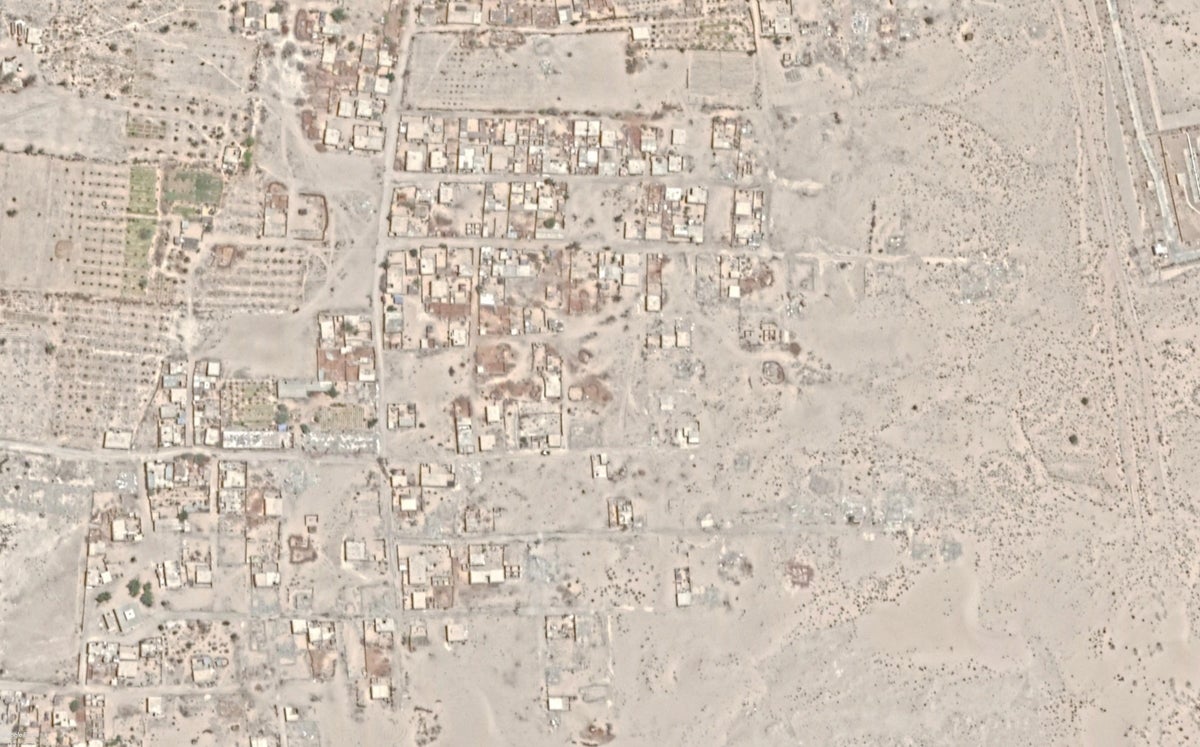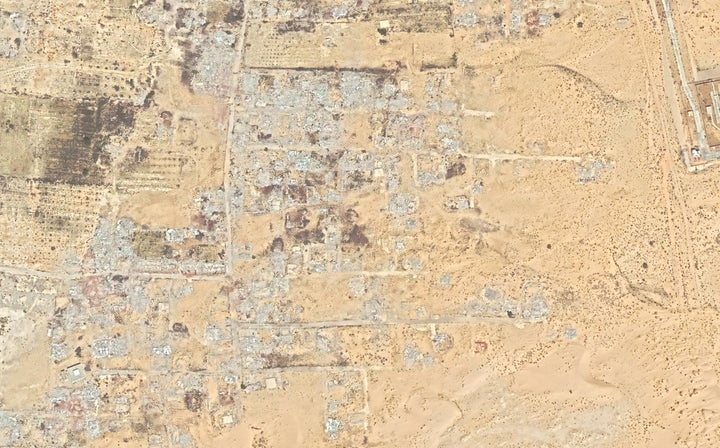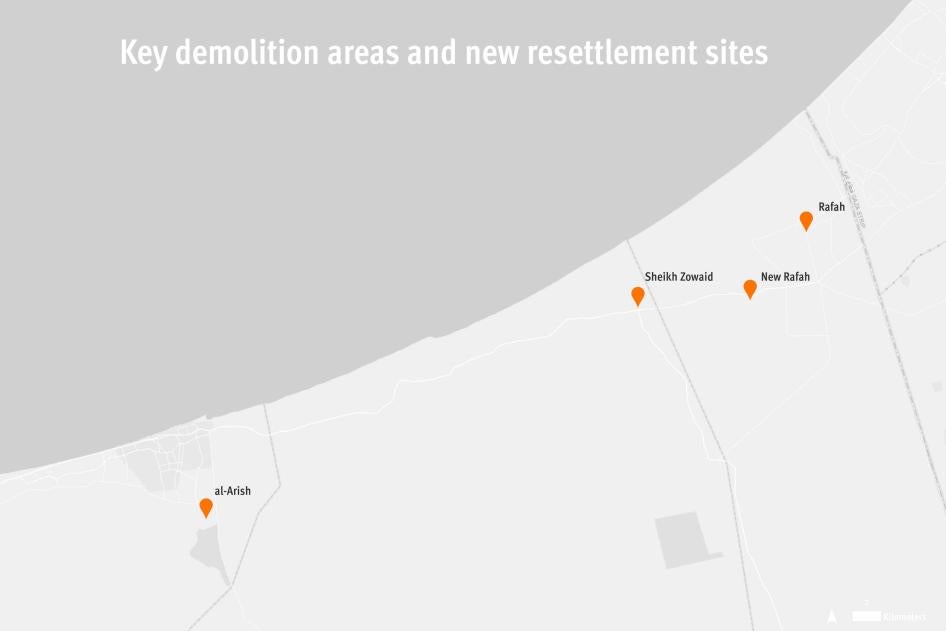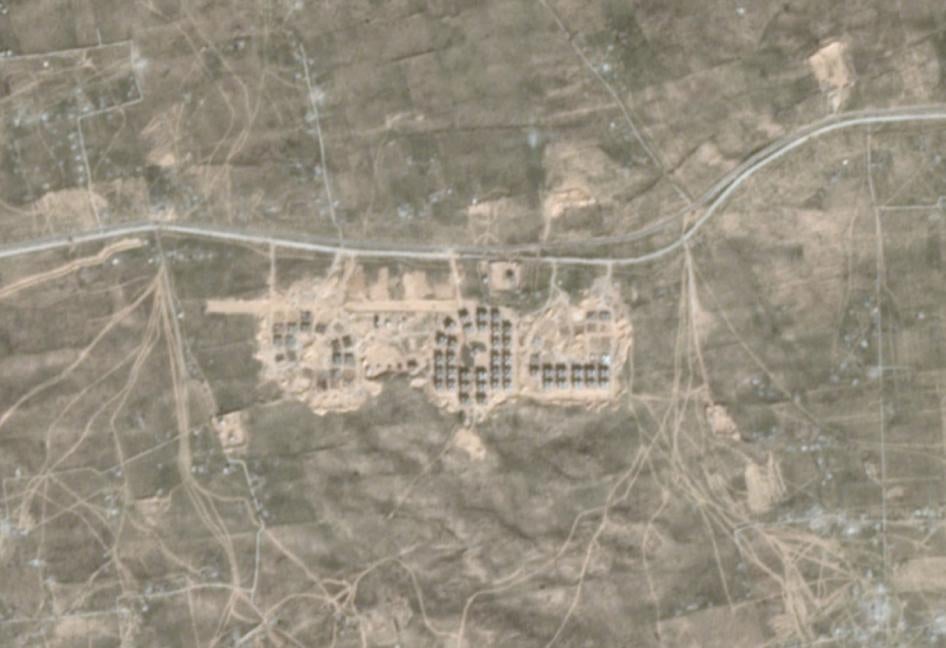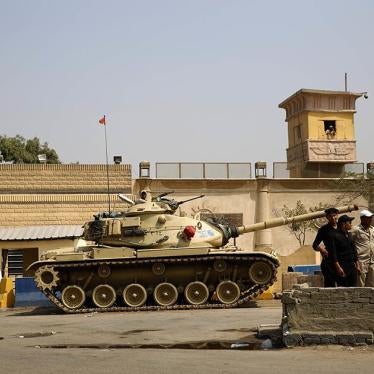(Beirut) – The Egyptian military’s continuing home demolitions and forced evictions during the armed conflict in North Sinai governorate are violations of international humanitarian law, or the laws of war, and likely amount to war crimes, Human Rights Watch said today.
Between late 2013 and July 2020, the army destroyed at least 12,350 buildings, mostly homes, most recently in the al-Arish area. The army has also razed, ruined, and closed off approximately 6,000 hectares of farmland, mostly since mid-2016. The government has provided little information beyond broad claims in the media that the evictions and demolitions were needed for security in the protracted fight with the armed group Wilayat Sina’, a local Islamic State (also known as ISIS) affiliate responsible for attacks against military targets and civilians. Thousands of these evictions and demolitions appear to violate the laws of war, which prohibit such actions except for absolute military necessity or to ensure the security of the civilians involved. War crimes are serious violations of international humanitarian law, committed with criminal intent.
“Over the past seven years in North Sinai, the Egyptian army has unlawfully evicted tens of thousands of residents, destroying their homes, farms, and livelihoods,” said Joe Stork, deputy Middle East and North Africa director at Human Rights Watch. “The demolitions and evictions reflect an abusive official mentality that dismisses the well-being of Sinai residents, which is key to the region’s security and stability.”
Since late 2017, the military has razed property to create a buffer zone in the city of al-Arish and to complete another in Rafah. It has also destroyed hundreds of homes outside these buffer zones. Much of the destruction proceeded without formally designating the coordinates of the areas to be razed, without giving specific reasons, and without setting a fair compensation process. The majority of families evicted since late 2017, as well as hundreds – likely thousands – of families whose properties have been demolished since 2013, have yet to receive compensation. The government offered no clear plans for when evicted residents can return home or indicated whether it has any such plans.
Human Rights Watch in 2015 and 2018 documented extensive home demolitions in North Sinai beginning in 2013. Until early 2018, the army mainly evicted people from residential areas in and around the city of Rafah, on the border with Gaza and Israel.
Recent analysis of a time series of dozens of high-resolution commercial satellite images recorded between December 4, 2017, and July 1, 2020, found that during that period the military demolished about 4,000 buildings in and around al-Arish city, mainly to build a buffer zone surrounding the formerly civilian al-Arish airport south of the city, used since 2013 for military purposes.
Satellite imagery recorded in December 2020 showed continuing demolition in Rafah area. Most of the demolished buildings in al-Arish appear to have been residential or commercial buildings, almost 3,500 of them destroyed in 2018 alone, after President Abdel Fattah al-Sisi said he would “use extreme violence and a truly brute force” in Sinai following an attack on the airport in December 2017. The military then escalated its operations, including imposing severe restrictions on movement that drove thousands of residents to the edge of a humanitarian crisis between February and May 2018. Earlier, possibly as early as 2014, the army had demolished about 1,500 buildings in al-Arish.
Human Rights Watch analysis of satellite imagery found that of the roughly 5,500 buildings demolished in al-Arish since 2014, over 2,000 were located outside the security perimeter. Media reports and witnesses who spoke previously with Human Rights Watch said the army was demolishing homes of suspected members of Wilayat Sina’ or their relatives. These extensive demolitions contradict the North Sinai governor’s statement in January 2018 that the demolitions “will not touch al-Arish city.”
Human Rights Watch found no record since 2013 of official decrees that mandate or regulate the evictions in or around al-Arish city or specify compensation.
In addition, between December 2017 and July 2020, the army destroyed about 700 shacks and temporary structures within the al-Arish buffer zone, and dozens of shacks outside it. The military frequently claims that these makeshift communities are infiltrated by armed groups. Witnesses told Human Rights Watch, and quasi-official statements and media reports show, that poorer evictees usually find no alternative but to build shacks in new makeshift communities.
Analysis of other satellite imagery recorded between August 2013 and August 2020 found that almost all farmland within the airport buffer zone, about 1,800 hectares, had been likely razed, as well as 800 hectares of farmland in and around al-Arish city, mostly between August 2016 and August 2019. Based on imagery analysis, the army also razed, ruined, and closed off 3,500 hectares of farmland in and around Rafah, particularly between August 2016 and August 2019. Residents on the ground corroborated this analysis.
The authorities did not respond to questions Human Rights Watch sent on January 11 and 26, 2021 to the Cabinet office, the Defense Ministry, and the State Information Service. Amid a strict information blackout on Sinai events, including prohibition of independent reporting, Egyptian officials routinely deny the forced nature of evictions there, and pro-government media uses “relocated” or “affected” to refer to evicted residents. “We didn’t evict anyone ... We gave residents money and razed the buildings and farms because it’s national security,” President al-Sisi said in October 2019, adding that the government “paid billions” in compensation.
Human Rights Watch documented previously that as of mid-2018 the military had destroyed at least 6,850 buildings in Rafah city. Satellite imagery as recent as December 2020 shows that demolitions continued outside the buffer zone south and west of Rafah city. Human Rights Watch found official lists in July 2020 indicating that at least 7,460 buildings have been surveyed and demolished inside the Rafah buffer zone alone.
Human Rights Watch reviewed media reports and official statements that, together with accounts of four displaced families interviewed jointly by Human Rights Watch and the Sinai Foundation for Human Rights, an independent organization, support previous Human Rights Watch findings that the compensation process has been opaque, slow, and lacking independent review or appeal mechanisms. Thousands of people were never listed for compensation or have yet to receive any.
The military’s home demolitions and forced evictions have been a main grievance of North Sinai residents, who have also experienced other serious abuses and war crimes at the hands of both the military and armed groups. Whether in peacetime or war, international human rights law generally prohibits forced evictions and home demolitions unless in exceptional situations and with proper consultation, enough notice, fair compensation, and redress mechanisms, all of which the Egyptian government has largely failed to provide.
“The Egyptian government should end abusive evictions and demolitions, accelerate fair, transparent compensation for everyone possible, and provide assurances that evicted residents can return home as soon as and whenever possible,” Stork said.
Background
Egyptian military demolitions in Sinai began as the conflict in Sinai intensified in late 2013 and escalated in October 2014, when the government issued a decree evicting residents from a 79-square-kilometer buffer zone that included the entire city of Rafah, where over 70,000 people were living. The decree stated that the area should be “evacuated” and “isolated” but did not provide reasons or mention demolitions. The demolitions had begun months earlier, and include at least 3,250 buildings demolished between July 2013 and August 2015, and about 3,600 buildings demolished between January and April 2018, hundreds of them outside the buffer zone. Rafah was almost entirely demolished by mid-April 2018.
The government has released no official statistics, but Human Rights Watch estimates that well over 100,000 of North Sinai’s roughly 450,000 residents have been displaced or otherwise left the region since 2013, primarily as a result of the home demolitions but also by those fleeing intensifying military hostilities. Some displaced families remain in North Sinai and have been displaced more than once. Others sought refuge elsewhere in Egypt, in many cases with little or no assistance from the government in finding alternative housing or jobs.
In 2014 and 2015, the government provided some information about the numbers of houses demolished and the compensation process, but as demolitions widened the government went largely silent.
The Sinai Foundation for Human Rights, founded in 2020, shared with Human Rights Watch a leaked official database that includes a list of 10,468 families (about 41,000 residents) displaced from Rafah and neighboring Sheikh Zuwayed as of October 2018 who remained inside Sinai, mostly in al-Arish and Baer al-Abd. Media reports in October 2019 said the North Sinai governorate was updating the database and surveying evictees who moved to mainland Egypt but no such information has been made public.
Unlawful Nature of North Sinai Demolitions
Forced evictions or transfers of a civilian population on the one hand and home demolitions and dispossession of private property on the other are related but distinctive issues. International human rights law and international humanitarian law generally prohibit both when imposed by state authorities, except as measures of last resort to protect civilians or for “absolute” military necessity. Human Rights Watch has previously described how the situation in North Sinai since 2014 amounts to a non-international armed conflict, to which laws of war apply. Hostilities at an intense level beyond sporadic disturbances have continued for years. The government has mobilized tens of thousands of troops, including infantry, air, and naval forces, and all parties to the conflict have organized command structures. Ordering unlawful forcible displacement of civilian populations and the extensive seizure and destruction of their homes and farms can constitute violations of laws of war that are serious enough to amount to war crimes.
The assessment that demolitions and displacement in North Sinai violate international humanitarian law is based on several elements that Human Rights Watch examined. First, the government has failed to produce compelling evidence that destroying thousands of homes and evicting residents from the whole city of Rafah was an absolute military necessity or was needed to protect the civilians living there. Protecting lives might justify displacement but not demolitions. Officials said in media statements that those evictions were needed to destroy the smuggling tunnels between Egypt and Gaza, but failed to explain why other means were not considered. The demolitions, even if unavoidable, were disproportionate and unreasonable.
Official statements about which areas would be cleared of residents were contradictory, reflecting arbitrariness and a lack of proper communication. For example, the government claimed in a rare formal statement in September 2015 that the Rafah evictions were to protect the lives of civilians. But officials made no such claims earlier, when the stated focus was on destroying the tunnels. In October 2019 President al-Sisi again said that the Rafah evictions were to “get rid” of the tunnels. The massive evictions and demolitions west of Rafah as armed militants expanded their strongholds reflect the Egyptian military’s overbroad interpretation of security inconsistent with the limitations imposed by the laws of war by which security forces justify extensive evictions and demolitions in villages and towns where the army faced frequent attacks by armed groups. This included demolishing hundreds of homes outside of the declared buffer zone in Rafah and Sheikh Zuwayed without providing reasons. Demolitions around al-Arish airport from late 2017 followed the same pattern: the government apparently did not consider less harmful solutions to secure the airport or to carry out strictly needed evictions in a proportionate way. Salah Sallam, a member of the National Council for Human Rights, on October 30, 2018, questioned the need for extensive airport demolitions: “The alternatives, to preserve residents’ property, exist with studies….” he said.
The government rejects the view that the situation in North Sinai amounts to an armed conflict governed by the laws of war even though the evidence strongly suggests it does. However, international human rights law applies at all times, including in peacetime and during conflict and guarantees strong protections against forced evictions, displacement, and dispossessions.
Under international human rights law, demolitions should only be carried out where strictly unavoidable. The government failed, when carrying out demolitions and evictions in Sinai, to meet key human rights standards, including: access to information, adequate consultation with residents, sufficient notice, a fair compensation process, and independent redress mechanisms, as explained in this and previous Human Rights Watch reports about Sinai evictions. When unavoidable, evictions should never violate “the rights to life, dignity, liberty, and security of those affected,” according to the UN guidance on forced evictions. The government severely undermined evictees’ adequate standards of living and inflicted severe distress by failing to provide alternative housing, sources of income, means of transport, and advance or swift compensation. The army typically gave Rafah residents 48-hour notice of evictions and sometimes restricted movement and the flow of goods to effectively force people to leave. Many evictions were carried out during rainy and cold weather which, in addition to a nighttime curfew since October 2014, made transport arrangements more difficult. Evictions were not only carried out without proper consultation, but were largely based on draconian laws, including the 1958 Emergency Law, imposed in North Sinai since October 2014, and the 1960 General Mobilization Law. These laws provide for imprisonment for anyone opposing government orders such as evictions. Security forces have arrested several of the few Sinai activists who openly opposed forced evictions, such as Ashraf al-Hefny in December 2019 and Ashraf Ayoub in August 2020.
The government made it hard for those evicted to find new homes and demolished their shacks in makeshift communities. According to media reports, the authorities also systematically demolished new homes of many who settled in the neighboring governorate of Ismailiya, claiming the new buildings lacked necessary building permits. And many Sinai residents who left fearing for their lives received little or no help or instructions from the government. The military demolished many deserted homes without offering justifications.
The UN special rapporteur on the right to adequate housing, in her report following an official mission in Egypt in late 2018, wrote that her mission faced acts of reprisals and that she was “not able to meet with the Ministry of Defense to seek additional information from the government on alleged security-related forced evictions in North Sinai.” Her report also noted that “the destruction of homes in retaliation for suspected terrorist activities is a prima facie violation of the right to housing.”
Evictions Feared Permanent
The government has issued no information regarding a time frame for when those displaced might return to their homes or whether it has any such plans. The demolition of homes following evictions casts doubt on whether they can return, as do demolitions of government buildings, factories, schools, health facilities, and mosques.
In 2015, over a dozen residents told Human Rights Watch that, to be eligible for compensation, they were coerced by officials to sign forms falsely stating they had voluntarily transferred their property to the state and pledging not to build again within the areas from which they were removed. Ahmed Salem, director of the Sinai Foundation for Human Rights, citing communications with three Sinai residents in January 2020, told Human Rights Watch that this has been the case throughout evictions.
Officials frequently claim that Sinai residents lack sufficient legal documents to prove land ownership, using this to justify not compensating residents for their lands and farms. For decades, Sinai residents registered land ownership with community leaders with quasi-official documents, known as “green contracts,” rather than with the central government. Under international law, including the African Charter on Human and Peoples’ Rights, which Egypt ratified in 1984, the right to property should be recognized on the basis of traditional occupation and use, and on people having been treated as the owners, rather than solely on formal government state recognition of ownership.
Opaque, Slow, and Unfair Compensation Process
None of the al-Arish evictees and owners appear to have received compensation as of December 2020, when the al-Arish City Council said it had begun preparing lists of eligible people evicted from the airport zone.
Human Rights Watch has interviewed 20 evicted residents and several Sinai activists since 2014 and reviewed dozens of official documents. Hundreds of evicted families and farm owners received some compensation in a slow and opaque process, while hundreds of others received none and are left not knowing whether they will be compensated or how much they might receive.
Most families interviewed said that the government provided no assistance and that their compensation was insufficient, a claim noted in the 2019 report of the UN special rapporteur on the right to housing. Residents have no chance to appeal evictions or the compensation before an independent judicial or administrative entity.
International guidelines state that forced eviction compensation should be offered before the authorities carry out evictions and should cover losses of personal, real or other property, and economic losses. Official lists that Human Rights Watch reviewed show that about 2,200 Rafah evictees were only compensated in 2020, years after their eviction.
The compensation ranged from EGP 50,000 (US$3,200) to EGP 1,900,000 ($121,330). In 2014 the government said it would pay EGP 800 to 1,200 ($50 to $72) for each square meter of a structure, but not land. Human Rights Watch found no indication that this calculation has taken into consideration the over 50 percent devaluation of the Egyptian pound in 2016.
In 2014, the government said it would provide no compensation for lost farmland, but years later the government began providing some compensation for lost farmland. In 2020, the Agriculture Directorate of North Sinai governorate listed about 600 farm owners in Rafah, Sheikh Zuwayed, and al-Arish eligible for compensation. The lists published did not indicate the amount or when owners would receive it. The government apparently compensates farm owners for only up to 100 trees, regardless of the farm size or how many trees it had. In 2018 and 2019 dozens of farmers received compensation, according to public records Human Rights Watch reviewed.
Witness accounts and official statements show that the authorities failed to survey entire neighborhoods and farms in Rafah, Sheikh Zuwayed, and al-Arish to fairly calculate the compensation before destroying them.
The UN special rapporteur on the right to adequate housing said in 2007 that “cash compensation should under no circumstances replace real compensation in the form of land and common property resources. Where land has been taken, the evicted should be compensated with land commensurate in quality, size and value, or better.”
The government offered no assistance or compensation for residents who left their homes fearing for their lives because of the armed conflict, and whose deserted homes and farms the military subsequently bulldozed or shelled. This was the case for the four families from Rafah, Sheikh Zuwayed, and Baer al-Abad whom Human Rights Watch interviewed in 2020 jointly with the Sinai Foundation for Human Rights.
A man from al-Tayara village, just outside the buffer zone in Rafah, whose 120-square-meter home the army demolished in September 2019 without compensation or alternative housing, said he and his family of seven were displaced twice – first from Rafah and later from Sinai. “The last time I saw my house was in September 2019 when it was demolished,” he said. “The army bulldozed it after they built an army checkpoint nearby. They destroyed all the buildings in the area.”
He said that two siblings whose homes inside the Rafah buffer zone were demolished in late 2018 had been offered cash compensation that was insufficient and “only for the structure, not for the land.” The man said that no one whose houses were demolished outside official coordinates of the Rafah buffer zone was offered compensation, and that at one point the government employees responsible for surveying houses to be demolished stopped visiting the area, so that hundreds of houses inside and outside the buffer zone were demolished un-surveyed. In November 2017, the army bulldozed another sibling’s house outside the buffer zone, also without offering compensation.
“Bulldozers came from a nearby army checkpoint,” he said. “People begged the driver to wait until they carry out their clothes and belongings. They hurried inside their homes, collecting what they could. Shortly, an army officer arrived in a Humvee. Once the bulldozer driver saw him, he started bulldozing the homes.”
Another man said that, despite fearing for their lives, he and his family remained in their home in Rafah until late 2018, waiting for officials to survey the home before demolishing it. They received “insufficient” compensation in mid-2020 only for the structure, he said, but not for their land. They had earlier been displaced, in July 2015, when the military demolished another home of theirs in Rafah before officials measured it, and for which he received no compensation.
North Sinai’s governor, General Mohamed Abdel Fadil Shousha, said on February 9, 2020, that the government would start accepting requests for compensation for demolished houses outside the Rafah buffer zone. On February 17, 2020, the Rafah City Council posted a form that residents whose houses were demolished outside the buffer zone without being surveyed should fill out and have certified by two clan leaders in the area to be eligible for compensation.
Another resident who lived east of Sheikh Zuwayed said that his family of eight and about 50 other families had to evacuate their homes in late 2018, fearing “indiscriminate shelling by the army and the killings by the armed groups.” He and many others moved temporarily to al-Sakadra village, north of Sheikh Zuwayed, he said. In mid-2020, the army evicted families from al-Sakadra but offered no compensation for their homes and farms, many of which, he believes, were destroyed in the armed conflict. The Sinai Foundation for Human Rights reported in August 2020 that the army used bulldozers and explosives to destroy several homes in al-Sakadra.
Opaque, Insufficient Resettlement Plans
In 2015, the government said it had begun building a “New Rafah” city west of the demolished city to accommodate displaced residents. Prime Ministerial Decree 2021 of 2015 shows a designated area of approximately 2.25 square kilometers, about 2.8 percent of the evicted Rafah area.
In July 2020, General Shousha said that the government would provide apartments to Rafah evictees “soon.” Satellite imagery recorded on December 10, 2020, shows 41 blocks of apparently uninhabited multi-story buildings and an additional 30 under construction. Photos published in local media in December 2020 show ongoing construction and vacant buildings.
Part of the land designated for New Rafah lies within the security perimeter along Rafah/al-Arish road, which Decree 233 of 2016 designated as military property. December 2020 satellite imagery shows that demolitions have increased dramatically since July in areas nearest to New Rafah, several military posts have been built around it, and additional farmlands razed, which casts serious doubt on any likelihood that residents will live there in the foreseeable future.
Armed militants have several times attacked and killed construction workers who work with the army and private companies in North Sinai in the construction of civilian and military installations.
A review of official statements in the media and on official Facebook pages of the Rafah City Council and North Sinai governorate found that, in 2020, the government provided subsidized rent contracts for about 1,100 apartments for families evicted from Rafah and Sheikh Zuwayed in a government social housing project in al-Sabeel area in al-Arish. Families were chosen by lot.
In March 2019, President al-Sisi issued Decree 132 designating about 11 square kilometers to build “New Baer al-Abd” city, west of al-Arish. Human Rights Watch found no sign of new construction there in satellite images recorded as of February 2021.
